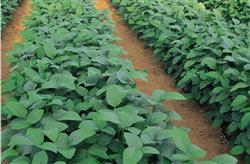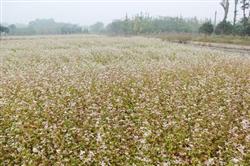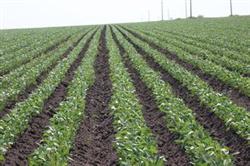Cultivation and management skills of soybean in spring

With the change of market, consumption habits and the adjustment of agricultural industrial structure, the planting area of soybean has expanded rapidly. Through the promotion of fine varieties and high-quality seeds, we hope to put an end to the harm of fake and shoddy seeds, promote the development of soybean industry, and serve to meet market demand and increase farmers' income. 1. The characteristic of soybean is warm. The seeds begin to germinate at 10-12 ℃, the optimum temperature for growth is 15-20 ℃, the optimum temperature for growth is 20-25 ℃, the suitable temperature for flowering and podding is 20-28 ℃, the pod setting is delayed at low temperature, and the plants with high temperature end ahead of time if the temperature is lower than 14 ℃. Seed germination requires more moisture, and the flowering stage requires soil water content of 70-80%, otherwise the bud shedding rate will increase. Soybean absorbs less than 15% of the total fertilizer before flowering, while the flowering and podding stage accounts for more than 80% of the total fertilizer absorption. Second, the main points of cultivation: 1, soil selection. As the root system of soybean is well developed, loam with deep soil layer, irrigation and drainage conditions and medium fertility should be selected for planting. 2. sow seeds at the right time. The seedlings cultivated in the small arch shed are generally raised in early February with a seedling age of about 25 days, planted in the small arch shed in early March and harvested in early May; sowed in the middle and late March of plastic film mulching cultivation in the open field, harvested in the middle of June, and can be directly seeded in the first and middle of April, with 2-3 grains per hole. 3. Reasonable close planting. The planting method of small border and narrow row is adopted, the width of the border is 80 cm, the distance between two rows of holes is 40 cm, and the distance between holes is about 20 cm. The cover soil should not be too thick. Otherwise, the seeds are perishable and not easy to emerge. 4. Fertilizing scientifically. Base fertilizer 150-200 jin per mu of calcium superphosphate. The first fertilizer was applied within one week after emergence, 30 jin of ammonium bicarbonate per mu and 30 jin of calcium superphosphate were mixed evenly, each load of water was mixed with 3 jin of border; the second fertilizer was applied in the following week, 40-50 jin of ammonium bicarbonate per mu and 30 jin of calcium superphosphate were mixed evenly, 4-5 jin per load of water was applied in the middle of the border; about 30 days after emergence, 10-15 jin of urea was applied per mu, and 30 jin of compound fertilizer was mixed evenly in the middle of the border. In the future, look at the seedling potential to replenish fertilizer, and one and a half ditch water should be irrigated after each fertilization. 5. Field management. After emergence, the first intertillage was carried out to promote root growth when growing to two compound leaves, and the second intertillage was carried out in the later stage of branching combined with trench cleaning and soil cultivation. Attention should be paid to preventing the harm of voles at the initial pod stage, and attention should be paid to eliminating stagnant water in the field in the pod filling stage to prevent rotten pods and ensure high yield. 6. Disease and pest control. To prevent underground pests, it is better to prepare holes with phoxim granules.
- Prev

Cultivation techniques of autumn buckwheat after flood
Buckwheat is a good crop for filling leisure and disaster relief because of its short growth period, strong adaptability, moderate yield and high nutritional value, and can be planted from south to north in our province. The key technical links are as follows: first, sowing at the right time. Buckwheat likes warm and cool environment, is afraid of frost, and sows too early or too late, which will seriously affect the yield. Along the river in our province.
- Next

High-yield and High-efficiency cultivation Model and matching techniques of Maize intercropping Sweet Potato among Spring Soybean
Now is the time to sow spring soybeans and spring corn. Experts from the Provincial Agriculture Department warned that the sowing time span of spring soybean and spring corn is long, the weather changes quickly, and the sowing conditions are very different, so it is not suitable to sow seeds blindly in advance. Suitable sowing time is introduced by experts from the end of March to the middle of May. Under conventional cultivation, our province.
Related
- The first cup of black tea in spring, the flavor and history of tea gardens in Kenya, Africa
- The computer can not only choose potatoes, but also grow tea rice. AI will grow winter oolong tea champion.
- It is not only the inflated tea bitten by insects, but also engraved with the four seasons tea in Beipu.
- The Oriental Beauty Tea Festival in Zhuxian County takes the stage at the weekend to experience the plus-size feast of oil tea.
- & quot; Oriental Beauty Tea & Exploration of Emei in Hsinchu, the hometown of quot;
- The new variety of strawberry "Tainong 1" dessert is the first choice with mellow aroma. Crimson gorgeous
- History of Tea in Taiwan: from Wild Inner Mountain to Export Tea Garden
- Two types of Taiwan Oriental Beauty Black Tea won the British three-Star Award for Childhood Tea Xiang Zhang Jiaqi changed from pilot to champion tea maker.
- Banana species and varieties: the planting history of Taiwan Xianren banana and dwarf banana is long, is banana disease resistant?
- Coffee planting Technology: Qianjie Coffee from Seedling to harvesting

